The Museum of Paleontology also publishes an occasional series of monographs and thematically related papers in the larger format University of Michigan Papers on Paleontology. This was started in 1972, and 37 volumes have been published to date. These generally range in length from about 50 to 200 pages.
Digital copies are available and can be found on the museum's profile page in the University of Michigan's digital library, Deep Blue. Hard copies of these publications are no longer available.
Highlight of Publications from Papers on Paleontology
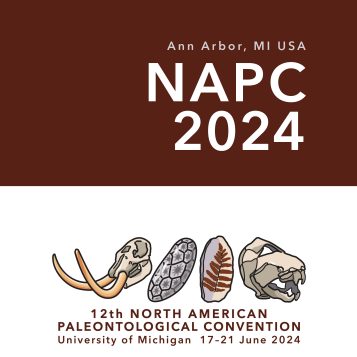
39. 12TH NORTH AMERICAN PALEONTOLOGICAL CONVENTION UNIVERSITY OF MICHIGAN 17-21 JUNE 2024
Wilson Mantilla, Jeffrey; Friedman, Matt
WELCOME TO ANN ARBOR AND THE UNIVERSITY OF MICHIGAN
Welcome to the 12th North American Paleontological Convention (NAPC) at the University of Michigan. We’re excited that you’re able to join us! The first NAPC, held at the Field Museum 55 years ago, marked a break from specialist meetings by bringing together researchers from all areas of paleontology. This inclusive format makes NAPC a fertile setting for developing new research directions and collaborations. With well over 700 delegates and presentation abstracts, we look forward to the novel ideas that will emerge from your...
See More
38. Skeleton of Late Paleocene Plesiadapis Cookei (Mammalia, Euarchonta): Life History, Locomotion, and Phylogenetic Relationships
Boyer, Douglas M.; Gingerich, Philip D.
Plesiadapis cookei is a large-bodied plesiadapiform euarchontan (and potential stem primate) known from many localities of middle Clarkforkian North American Land Mammal age, late Paleocene epoch, in the Clarks Fork Basin of northwestern Wyoming. Most specimens are gnathic and dental remains, but one specimen, University of Michigan Museum of Paleontology (UM) 87990, is a relatively complete skeleton preserving the skull, much of the axial skeleton, forelimbs, and hind limbs. Description, measurement, and illustration of the UM 87990 skeleton of P. cookei provides new information...
See More37. Late Eocene Sea Cows (Mammalia, Sirenia) from Wadi Al Hitan in the Western Desert of Fayum, Egypt
Iyad S. Zalmout, Philip D. Gingerich
The Eocene sea cows Protosiren, Eotheroides, and Eosiren have been known for more than a century from skulls and jaws found at Gebel Mokattam near Cairo and Birket Qarun near Fayum in Egypt. Protosiren and Eotheroides are known from Gebel Mokattam (Lutetian, middle Eocene), and Eosiren is known from north of Birket Qarun (middle Priabonian, late Eocene). In recent years we have collected exceptionally complete skeletons of Protosiren and Eotheroides of intermediate early Priabonian age in Wadi Al Hitan in the Western Desert west...
See More36. Earliest Eocene Mammalian Fauna from the Paleocene-Eocene Thermal Maximum at Sand Creek Divide, Southern Bighorn Basin, Wyoming
Kenneth D. Rose, Amy E. Chew, Rachel H. Dunn, Mary J. Kraus, Henry C. Fricke, Shawn P. Zack
An extensive earliest Eocene mammalian fauna is described from the PETM interval of Sand Creek Divide, about 17 km northeast of Worland, Wyoming. The assemblage, consisting of more than 1000 specimens representing 56 species, was collected over the last decade by surface prospecting, screen-washing, and limited excavation. Samples come from more than 40 localities spread throughout a 45-m section representing the entire PETM (~200 ka). Carbon isotope records from bulk sediment and from mammalian tooth enamel were compiled and used to delimit the PETM and to correlate the Sand Creek...
See More35. The Tiffanian Land-Mammal Age (Middle and Late Paleocene) in the Northern Bighorn Basin, Wyoming
Ross Secord
The Tiffanian North American land-mammal age is an informal biochronologic unit that spans 4.5
myr of the middle and late Paleocene. It is preceded and succeeded by the Torrejonian and Clarkforkian land-mammal ages, respectively. The Tiffanian was initially based on a small collection of mammals from southern Colorado, but faunas of Tiffanian age are now known throughout the Rocky Mountain region. The richest and most complete sequence of middle and late Tiffanian faunas known occurs in the northern Bighorn Basin. These faunas are the primary basis for regional Tiffanian biochronology...
34. Form, Function, and Anatomy of Dorudon atrox (Mammalia, Cetacea): An Archaeocete from the Middle to Late Eocene of Egypt
Mark D. Uhen
Dorudon atrox is a medium-sized archaeocete cetacean, around five meters in length from snout to tail in life, and is known from the Birket Qarun and Gehannam Formations of Fayum, Egypt. These formations are primarily Bartonian, but probably straddle the Bartonian-Priabonian boundary. The Bartonian is the last European marine stage in the middle Eocene, while the Priabonian is the first marine stage in the late Eocene, and the formations from which D. atrox are recovered are around 41 to 40 million years old. Anatomical features found in D. atrox and its close relatives (Family...
See More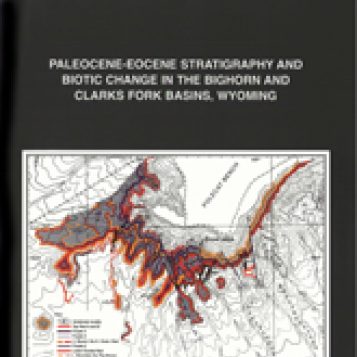
33. Paleocene-Eocene Stratigraphy and Biotic Change in the Bighorn and Clarks Fork Basins, Wyoming
Philip D. Gingerich, Others
The Bighorn and Clarks Fork basins of northwestern Wyoming are world-renowned for their brightly-colored fossil beds yielding mammals and other vertebrates of the Paleocene and early Eocene epochs. The first collections were made by Jacob Wortman in 1880 and 1881 while employed by Edward Drinker Cope of Philadelphia, one of the best known American vertebrate paleontologists of the nineteenth century. Wortman was very successful, and as a result Cope was able to describe many new genera and species based on this collection. William Benyman Scott of Princeton University tried to duplicate...
See More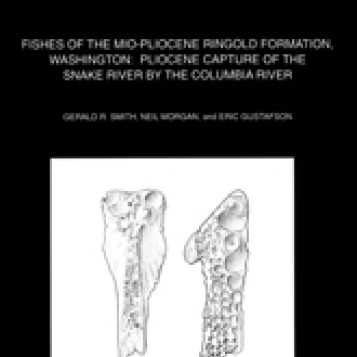
32. Fishes of the Mio-Pliocene Ringold Formation, Washington: Pliocene Capture of the Snake River by the Columbia River
Gerald R. Smith, Neil Morgan, Eric Gustafson
Three rich, warm-water fish faunas occur in the Pliocene section of the Ringold Formation, near the Columbia River-Snake River confluence in south-central Washington. The fish fossils are in or near the Pasco Basin, where they accompany three mammalian local faunas of Blancan land mammal age. The White Bluffs local fauna is the earliest of the three Pliocene faunas. It is known from many localities at about 182 m (600 ft) elevation in fluvial sediments in the bluffs east of the Columbia River from 9 to 29 km north of Richland, in Franklin County, Washington. The age of the White Bluffs...
See More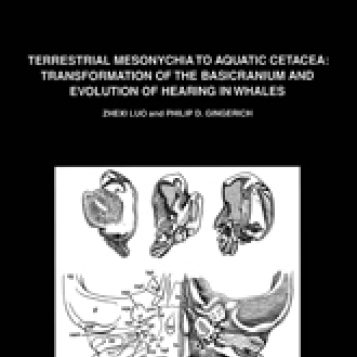
31. Terrestrial Mesonychia to Aquatic Cetacea: Transformation of the Basicranium and Evolution of Hearing in Whales
Zhexi Luo, Philip D. Gingerich
Morphological and stratigraphic evidence indicates that land-living mesonychian ungulates are broadly ancestral to early amphibious and later aquatic cetaceans. The transition from terrestrial ungulates to aquatic whales is a transition from life in air to life in water. Air and water differ in density and are very different media for sound propagation. Thus perception of air-borne sound by land mammals and perception of water-borne sound by whales require markedly different functional adaptations. Here we describe and compare the basicranial morphology of mesonychian ungulates and...
See More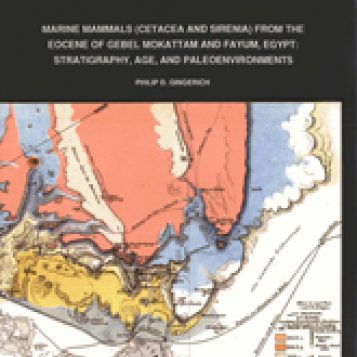
30. Marine Mammals (Cetacea and Sirenia) from the Eocene of Gebel Mokattam and Fayum, Egypt: Stratigraphy, Age, and Paleoenvironments
Philip D. Gingerich
Gebel Mokattam and Fayum are well known among vertebrate paleontologists for their rich and diverse faunas of Eocene marine mammals. Ten cetacean and seven sirenian species have been named from these two areas. The Eocene stratigraphy of each is reviewed here, and Fayum stratigraphy is supplemented with new observations. The Mokattam Formztion and most of the Giushi Formation at Gebel Mokattam are Lutetian and Bartonian (middle Eocene) in age, and these record deposition offshore in marine shelf and shallow shelf environments. The Maadi Formation at Gebel Mokattam is Priabonian (late...
See More29. Evolution of Paleocene and Eocene Phenacodontidae
J. G. M. Thewissen
The family Phenacodontidae (Condylarthra, Marnrnalia) occurs in the Paleocene and Eocene of North America and Europe. North American phenacodontids are among the most abundant mammals during their range from middle Torrejonian (63 Ma) through Bridgerian land-mammal ages (49 Ma). In Europe, phenacodontids are rare and known only from early and middle Eocene deposits. This study evaluates the pattern of evolution, and the geographic and chronologic distribution of phenacodontid taxa, and investigates some causal factors for these patterns. (Go to the link and see more of this paper.)...
See More28. New Earliest Wasatchian Mammalian Fauna from the Eocene of Northwestern Wyoming: Composition and Diversity in a Rarely Sampled High-Floodplain Assemblage
Philip D. Gingerich
A new earliest Wasatchian mammalian fauna is described from twenty localites in the Bighorn and Clarks Fork basins of northwestern Wyoming. These localities are in greenish gray sandstones and brightly colored mudstones within the Clarkforkian-Wasatchian boundary sandstone complex, or in brightly colored mudstones correlative with and lateral to the boundary sandstone. The fauna represents a new basal zone of the Wasatchian, here called zone Wa0
Thirty-five mammalian genera and 41 mammalian species are known from zone Wa0. Three genera and ten species are...
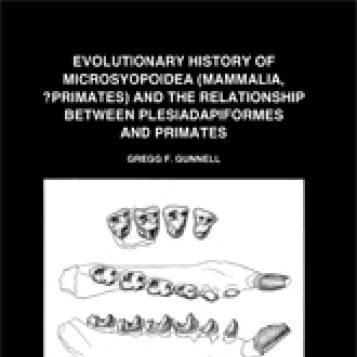
27. The Evolutionary History of Microsyopoidea (Mammalia, ?Primates) and the Relationship between Plesiadapiformes and Primates
Gregg F. Gunnell
Plesiadapiformes is the first group of primate-like mammals known in the fossil record. Plesiadapiformes first appear in the Paleocene (Puercan Land Mammal Age) in sediments of the Western Interior of North America. The relationship of Paleocene plesiadapiforms to Eocene primates of modem aspect (euprimates) and relationships among various families, genera, and species of plesiadapiforms are uncertain. In particular, the relationship of Microsyopoidea to plesiadapiforms has been questioned. Morphological and functional studies of dental and cranial remains of plesiadapiforms presented...
See More26. The Clarkforkian Land-Mammal Age and Mammalian Faunal Composition across the Paleocene-Eocene Boundary
Kenneth D. Rose
The Clarkforkian is an early Cenozoic North American Land-Mammal Age following the late Paleocene Tiffanian and preceding the early Eocene Wasatchian. Controversy has surrounded recognition of the Clarkforkian as a valid land-mammal age, but new investigations in the type area, the Clark's Fork Basin (northern Bighorn Basin) of northern Wyoming, enable the Clarkforkian to be precisely defined and its stratigraphic limits accurately determined. As a result of a University of Michigan project in this area, more than 250 vertebrate localities (134 of Clarkforkian age) have been discovered...
See More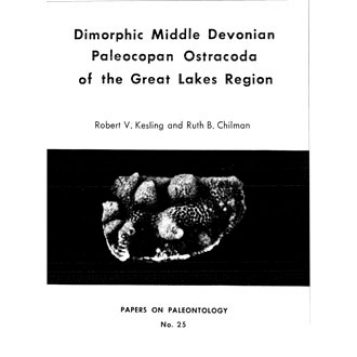
25. Dimorphic Middle Devonian Paleocopan Ostracoda of the Great Lakes Region
Kesling, R. V.; Chilman, R. B.
University of Michigan Deep Blue - digital version.
Publisher: University of Michigan
Year of Publication: 1987
Location: Ann Arbor, MI
Volume Number: 25
# of Pages: 244
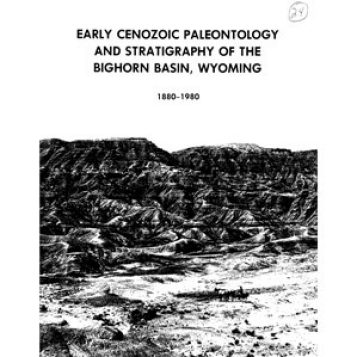
24. Early Cenozoic Paleontology and Stratigraphy of the Bighorn Basin, Wyoming
Gingerich, Philip D.
University of Michigan Deep Blue - digital version.
Publisher: University of Michigan
Year of Publication: 1980
Location: Ann Arbor, MI
Volume Number: 1
# of Pages: 156
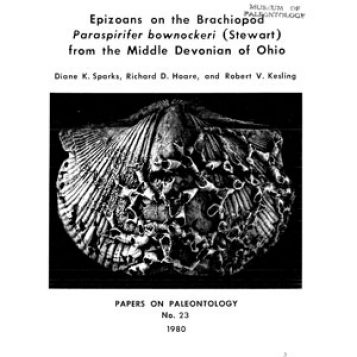
23. Epizoans on the Brachiopod Paraspirifer bownockeri (Stewart) from the Middle Devonian of Ohio
Sparks, D. K.; Hoare, R. D.; Kesling, R. V.
University of Michigan Deep Blue - digital version.
Publisher: University of Michigan
Year of Publication: 1930
Location: Ann Arbor, MI
Volume Number: 23
# of Pages: 110

22. Systematics of the Fissiculate Blastoidea
Macurda, D. B. , Jr.
University of Michigan Deep Blue - digital version.
Publisher: University of Michigan
Year of Publication: 1983
Location: Ann Arbor, MI
Volume Number: 22
# of Pages: 304
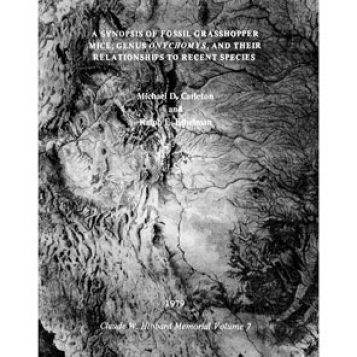
21. A Synopsis of Fossil Grasshopper Mice, Genus Onychomys, and their Relationships to Recent Species Claude W. Hibbard Memorial Volume VII
Carleton, M. D.; Eshelman, R. E.
University of Michigan Deep Blue - digital version.
Publisher: University of Michigan
Year of Publication: 1979
Location: Ann Arbor, MI
Volume Number: 21
# of Pages: 72
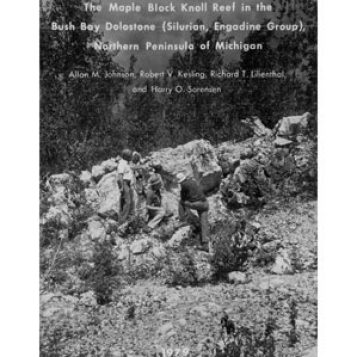
20. The Maple Block Knoll Reef in the Bush Bay Dolostone (Silurian, Engadine Group), Northern Peninsula of Michigan
Johnson, A. M.; Kesling, R. V.; Lilienthal, R. T.; Sorensen, H. O.
University of Michigan Deep Blue - digital version.
Publisher: University of Michigan
Year of Publication: 1979
Location: Ann Arbor, MI
Volume Number: 20
# of Pages: 40

19. Late Pleistocene Cold-Blooded Vertebrate Faunas from the Mid-Continental United States. I. Reptilia; Testudines, Crocodilia. Claude W. Hibbard Memorial Volume VI
Preston, Robert E.
University of Michigan Deep Blue - digital version.
Publisher: University of Michigan
Year of Publication: 1979
Location: Ann Arbor, MI
Volume Number: 19
# of Pages: 64
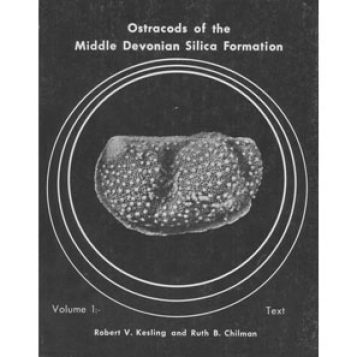
18. Ostracods of the Middle Devonian Silica Formation (2 books - Text and Plates)
Kesling, R. V.; Chilman, R. B.
University of Michigan Deep Blue - digital version.
Publisher: University of Michigan
Year of Publication: 1978
Location: Ann Arbor, MI
Volume Number: 18
# of Pages: 454

17. Devonian Strata of the Afton-Onaway Area, Michigan
Kesling, R. V.; Johnson, A. M.; Sorensen, H. O.
University of Michigan Deep Blue - digital version.
Publisher: University of Michigan
Year of Publication: 1976
Location: Ann Arbor, MI
Volume Number: 1
# of Pages: 156
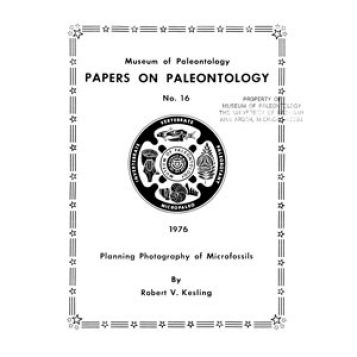
16. Planning Photography of Microfossils
Kesling, R. V.
University of Michigan Deep Blue - digital version.
Publisher: University of Michigan
Year of Publication: 1976
Location: Ann Arbor, MI
Volume Number: 1
# of Pages: 56

15. Cranial Anatomy and Evolution of Early Tertiary Plesiadapidae (Mammalia, Primates)
Gingerich, Philip D.
University of Michigan Deep Blue - digital version.
Publisher: University of Michigan
Year of Publication: 1976
Location: Ann Arbor, MI
Volume Number: 15
# of Pages: 156
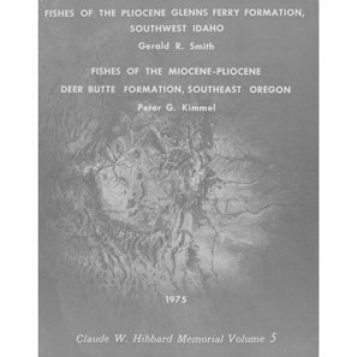
14. Fishes of the Pliocene Glenns Ferry Formation, Southwest Idaho; Fishes of the Miocene - Pliocene Deer Butte Formation, Southeast Oregon Claude W. Hibbard Memorial Volume V
Smith, Gerald R.; Kimmel, P. G.
University of Michigan Deep Blue - digital version.
Publisher: University of Michigan
Year of Publication: 1975
Location: Ann Arbor, MI
Volume Number: 1
# of Pages: 96
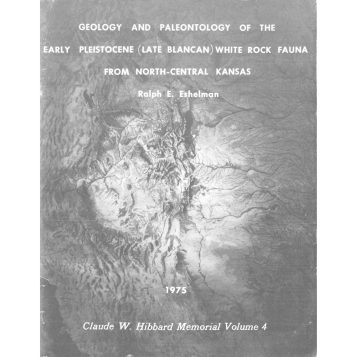
13. Geology and Paleontology of the Early Pleistocene (Late Blancan) White Rock Fauna from North-Central Kansas. Claude W. Hibbard Memorial Volume IV
Eshelman, R. E.
University of Michigan Deep Blue - digital version.
Publisher: University of Michigan
Year of Publication: 1975
Location: Ann Arbor, MI
Volume Number: 1
# of Pages: 68
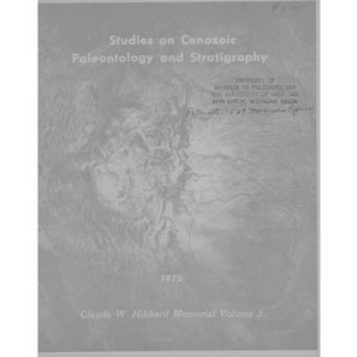
12. Studies on Cenozoic Paleontology and Stratigraphy. Claude W. Hibbard Memorial Volume III
Smith, Gerald R.; Friedland, N. E.
University of Michigan Deep Blue - digital version.
Publisher: University of Michigan
Year of Publication: 1975
Location: Ann Arbor, MI
Volume Number: 1
# of Pages: 156
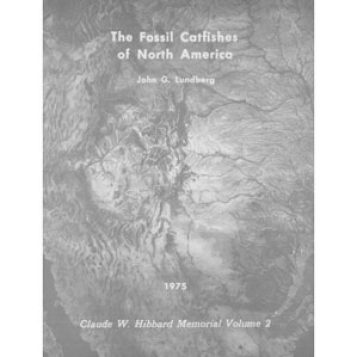
11. The Fossil Catfishes of North America. Claude W. Hibbard Memorial Volume II
Lundberg, J. G.
The Cenozoic fossil record of the teleost order Siluriformes (catfishes) is reviewed. Fossils from freshwater deposits
ranging from the late Paleocene through the Pleistocene represent two modern families: Ariidae and Ictaluridae.
The Eocene ariid genus Rhineastes, consisting of R. peltatus and R. smithi, has an uncertain relationship to modern
lineages. Rhineastes constitutes an exceptional freshwater record for its primarily marine family. Rhineastes radulus is a
nomen dubium. Bagre marinus and Arius felis, two living Atlantic and Gulf coast ariids, are known...
See More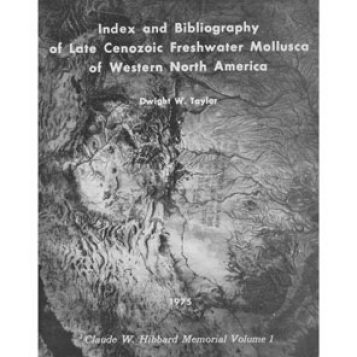
10. Index and Bibliography of Late Cenozoic Freshwater Mollusca of Western North America. Claude W. Hibbard Memorial Volume I
Taylor, D. W.
University of Michigan Deep Blue - digital version.
Publisher: University of Michigan
Year of Publication: 1975
Location: Ann Arbor, MI
Volume Number: 10
# of Pages: 388
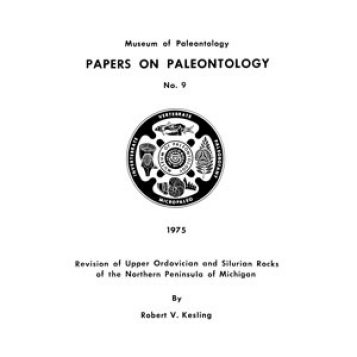
9. Revision of Upper Ordovician and Silurian Rocks of the Northern Peninsula of Michigan
Kesling, R. V.
University of Michigan Deep Blue - digital version.
Publisher: University of Michigan
Year of Publication: 1975
Location: Ann Arbor, MI
Volume Number: 9
# of Pages: 36

8. Strata and Megafossils of the Middle Devonian Silica Formation (Reprint 2012)
Robert V. Kesling, Ruth B. Chilman
To view how to order this publication from the Friends of the University of Michigan Museum of Paleontology click link below.
Link: FUMMP Silica Shale Book
Publisher: University of Michigan Museum of Paleontology
Month of Publication: December
Year of Publication: 2012 (reprint)
Location: Ann Arbor, MI
Volume Number: 8
# of Pages: 338
Availability: Contact The Friends of Paleontology...
See More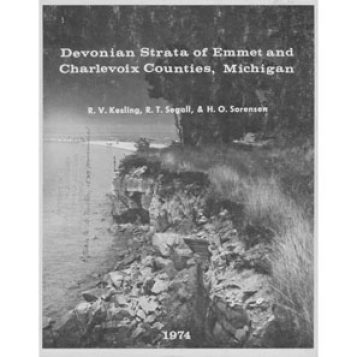
7. Devonian Strata of Emmet and Charlevoix Counties, Michigan
Kesling, R. V.; Segall, R. T.; Sorensen, H. O.
University of Michigan Deep Blue - digital version.
Publisher: University of Michigan
Year of Publication: 1974
Location: Ann Arbor, MI
Volume Number: 7
# of Pages: 197
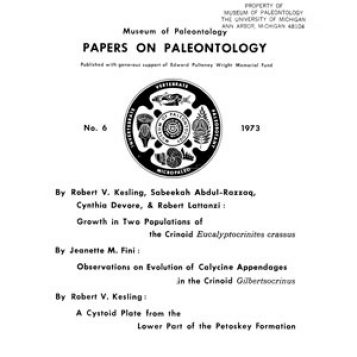
6. Growth in Two Populations of the Crinoid Eucalyptocrinites crassus; Observations on Evolution of Calycine Appendages in the Crinoid Gilbertsocrinus; A Cystoid Plate from the Lower Part of the Petoskey Formation
Kesling, R. V., Abdul-Razzaq, S., Devore, C. H., Lattanzi, R. D., Fini, J. M.
University of Michigan Deep Blue - digital version.
Publisher: University of Michigan
Year of Publication: 1973
Location: Ann Arbor, MI
Volume Number: 6
# of Pages: 64
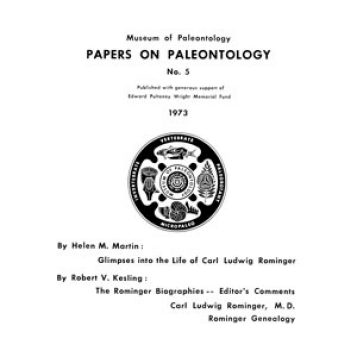
5. Glimpses into the Life of Carl Ludwig Rominger; The Rominger Biographies - Editor's Comments Carl Ludwig Rominger, M.D Rominger Geneaology
Martin, H. M., Kesling, R. V.
University of Michigan Deep Blue - digital version.
Publisher: University of Michigan
Year of Publication: 1973
Location: Ann Arbor, MI
Volume Number: 5
# of Pages: 64
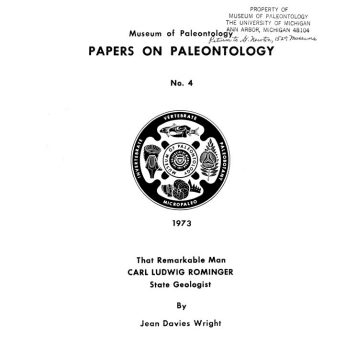
4. That Remarkable Man Carl Ludwig Rominger State Geologist
Wright, Jean D. (Jean Davies)
1820- 1854: BIRTH IN SCHNAITHEIM, WUERTTEMBERG, GERMANY - - EARLY YEARS -- UNIVERSITY OF TUEBINGEN -- HONORS AND AWARDS -- THE REVOLUTION OF 1848 -- ARRIVAL IN AMERICA -- FIRST MEDICAL PRACTICE
University of Michigan Deep Blue - digital version.
Publisher: University of Michigan
Year of Publication: 1973
Location: Ann Arbor, MI
Volume Number: 4
# of Pages: 152
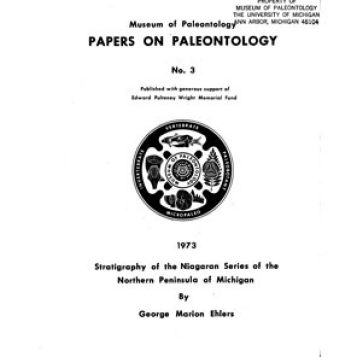
3. Stratigraphy of the Niagaran Series of the Northern Peninsula of Michigan
George Marion Ehlers
University of Michigan Deep Blue - digital version.
Publisher: University of Michigan
Year of Publication: 1973
Location: Ann Arbor, MI
Volume Number: 3
# of Pages: 208
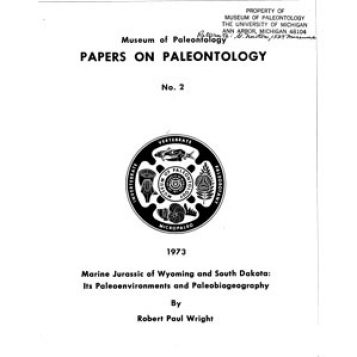
2. Marine Jurassic of Wyoming and South Dakota: Its Paleoenvironments and Paleobiogeography
Wright, R. P.
ABSTRACT -- During the Middle and Late Jurassic, the Twin Creek Limestone and Sundance Formation were
laid down in open shelf, lagoonal, and littoral environments. Local thinning and pinching out of strata and abrupt
vertical changes in lithology and biota within these formations are the result of deposition under variable shallow
water conditions and, contrary to previous interpretations, do not represent regional unconformities.
In Bajocian times, three bivalve associations existed. The Cam tonectes stygius fauna inhabited the outer
shelf in westernmost...
See More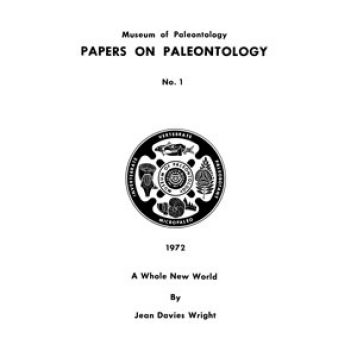
1. A Whole New World
Jean Davies Wright
University of Michigan Deep Blue - digital version.
Publisher: University of Michigan
Year of Publication: 1972
Location: Ann Arbor, MI
Volume Number: 1
# of Pages: 60

